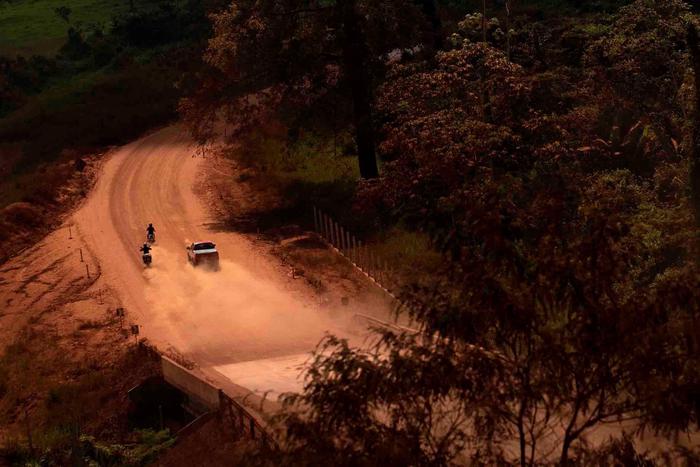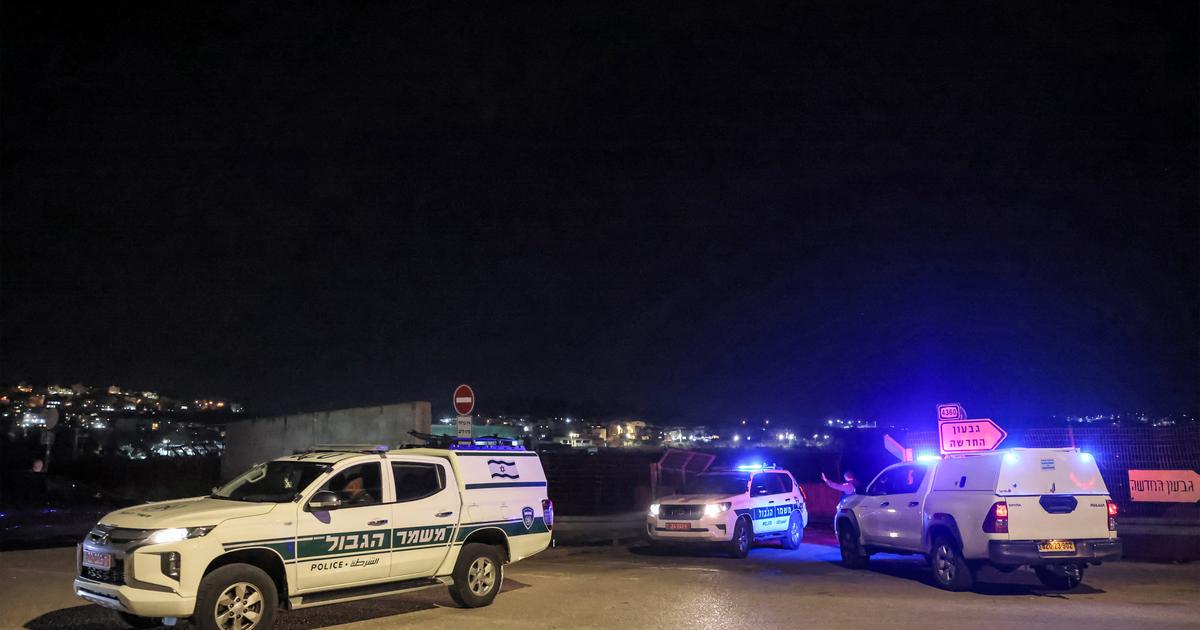YANOMAMI INDIGENOUS TERRITORY, Brazil - The illegal tin mine was so remote that, for three years, the massive pit it carved into the Amazon rainforest had gone largely unnoticed.
For this reason, when three mysterious helicopters flew over the area without warning, the miners who lived there took refuge in the jungle.
Members of the Brazilian environmental special forces team during a mission to destroy illegal mining equipment in Yanomami indigenous territory.
Photographs by Victor Moriyama
When the Brazilian environment special forces team emerged, the miners were no longer in sight, but the two large pumps in the mine were still vibrating in the mud.
The federal agents began to spray the machines with diesel
As they were about to light them, some two dozen Indians ran out of the jungle, carrying bows and arrows taller than them.
They were from the
Yanomami tribe
, and the miners had been destroying their land—and their tribe—for years.
But upon arrival, the Yanomami realized that these new visitors were there to help.
The agents were
dismantling the mine
and promised to deliver the miners'
supplies
to the Yanomami .
Felipe Finger, head of Brazil's environmental special forces team, burning a water pump at an illegal mine.
Photographs by Victor Moriyama
"Friends are not miners, no," said the only Yanomami man who spoke basic Portuguese, as other men crowded around him.
The explosion of illegal mining in this vast swath of the Amazon has created a
humanitarian crisis
for the Yanomami people, cutting off their food supplies, spreading malaria and, in some cases, threatening the Yanomami with violence, according to scientists and Government officials.
Miners use mercury to separate gold from mud, and recent analysis shows that Yanomami rivers contain mercury levels
8,600% higher
than what is considered safe.
Mercury poisoning can cause
birth defects and neurological damage.
A team from Brazil's environmental special forces prepares to land at an illegal tin mine on territory belonging to the Yanomami tribe.
Photographs by Victor Moriyama
The infant mortality rate among Brazil's 31,000 Yanomami now exceeds that of countries ravaged by war and famine:
1 in 10 children die, compared to about 1 in 100 in the rest of the country, according to government data.
Many of those deaths are preventable, caused by malnutrition, malaria, pneumonia and other diseases.
"A lot of diarrhea, vomiting," said the Yanomami from the mine, who did not want to give his name.
"There is no health, there is no help, there is nothing."
The environmental special forces team in an illegal mine.
Illegal mining increased in recent years when the country's right-wing former president opened up the Amazon to miners.
Photographs by Victor Moriyama
But now Brazil's new leftist president,
Luiz Inácio Lula da Silva
, has made saving the Yanomami his top priority in his campaign to stop the destruction of the Amazon.
The government declared a state of emergency in January and has airlifted severely malnourished people out of villages, set up a checkpoint at one of the main waterways into the territory and hunted down and destroyed active mines.
Agents arrest Edmilson Dias, a miner.
Photographs by Victor Moriyama
Although the miners began arriving in 2016, the crisis erupted under right-wing former president
Jair Bolsonaro,
who, after being elected in 2018, cut the staff and funding of agencies charged with protecting the jungle.
The area illegally mined in lush Yanomami territory quadrupled
during
his tenure to nearly 20 square miles, or about the size of New York's Manhattan borough, according to satellite data.
"On the one hand, you're happy because you're back fighting environmental crime," said Felipe Finger, head of Brazil's environmental special forces team, which led the operation at the tin mine.
"On the other hand, it's sad, because four years ago the jungle began to bleed, and it bled a lot."
The Yanomami helped the agents to evacuate the miners' cabin.
Photographs by Victor Moriyama
The government is fighting a real gold rush.
Thousands of prospectors have invaded the land in search of gold and other precious metals, and productive digging yields about
5 kilos of pure gold
a week, or about $300,000 on the local black market.
Researchers estimate that there are hundreds of active mines on Yanomami land.
For their part, the Yanomami at the mine had never heard of Lula or Bolsonaro, but they were clear that the miners had brought hardship.
The destruction of land caused by an illegal mine in Yanomami territory.
Photographs by Victor Moriyama
"The people are hungry," a Yanomami said as Finger set fire to the rumbling bombs.
Nearby, other agents were searching the miners' shelter, a clapboard hut with a fridge, stove and two Internet satellite dishes from Brazil's state-owned telecommunications company.
An abandoned airstrip used by illegal miners in Yanomami territory.
Photographs by Victor Moriyama
(Agents had recently discovered other miners using devices from
Starlink,
a satellite internet service run by Elon Musk.)
In the cabin they also discovered a miner who had taken too long.
A Yanomami mother with her baby in a children's hospital in Boa Vista.
Photographs by Victor Moriyama
Edmilson Dias said he had been working at the mine for two months, arriving by helicopter, earning $1,000 a week.
Now he was sitting on a stump, hands behind his back, two camouflaged officers with long rifles at his side.
However, he was still defiant.
Yanomami babies with advanced cases of malnutrition and pneumonia receiving treatment at the hospital.
Photographs by Victor Moriyama
"To tell the truth, I'm going from here to another mine," he said, adding that the money was
too good
to leave.
He stressed that the fight by the government and the Yanomami against the miners had only just begun.
"Mining is a fever," he said.
"You can't kill her."
Gold dealer Eric Silva displays his wares.
Photographs by Victor Moriyama
worse than it ever was
Instead of months, the Yanomami count moons, and instead of years, they keep track of harvests of the pupunha fruit.
Evidence suggests that they have lived in the Amazon for thousands of harvests.
The Yanomami pile sacks of flour, rice, and beans alongside clothing, pillows, and cans of sardines.
Photographs by Victor Moriyama
And unlike many other indigenous groups, their way of life still bears
some resemblance
to that of their ancestors.
In 370 remote jungle villages, several families share large domed huts, but tend their own plots of cassava, plantains and papaya.
Men hunt and women farm.
Yanomami taking supplies from the mining camp to their homes.
Photographs by Victor Moriyama
And they don't interact much with the outside world.
His first sustained contact with white American missionaries came in the 1960s.
Soon after, more Brazilians arrived, drawn into the Amazon by new roads and an appetite for gold.
With contact came new diseases, and thousands of Yanomami died.
Things got worse in the 1980s, when the gold rush brought more disease and violence.
In response, in 1992, the Brazilian government protected for the Yanomami some 37,000 square miles of jungle along the border with Venezuela, creating the largest indigenous territory in Brazil, an area larger than Portugal.
But in 2018, when Bolsonaro ran for president, prospectors were already rushing in again, buoyed by rising gold prices.
Illegal mining skyrocketed, and the Bolsonaro administration was largely a bystander.
"In the last four years, we have seen apathy, perhaps intentional," said Alisson Marugal, a federal prosecutor investigating the Bolsonaro administration's handling of Yanomami territory.
"They did not act, knowing that they were enabling a humanitarian crisis."
Marugal's office accuses the Bolsonaro government of weakening the indigenous health system, aggravating the crisis.
Health workers were sometimes prevented from buying food for the Yanomami, his office reported in November 2021.
The government had previously decided that it should provide 23 doctors to the Yanomami, but by the end of 2021 there were only 12.
Bolsonaro has said that his government carried out 20 operations to help indigenous groups, helping 449,000 people.
"Never has a government given as much attention and media to indigenous people as Jair Bolsonaro," he wrote on Twitter in January.
Today, the situation of many Yanomami children is unmistakable: They are starving.
Their skeletons can be seen through their skin, their emaciated faces and swollen bellies, a telltale sign of malnutrition.
A recent government study revealed that 80% of Yanomami children were below average height and half were underweight.
Dr. Paulo Basta, a government doctor who has studied the Yanomami for 25 years, said malnutrition among Yanomami children "is worse than ever."
During Bolsonaro's rule, 570 Yanomami children died from preventable causes including malnutrition, diarrhea, pneumonia and malaria, up from 441 in the previous four years, according to data compiled by a Brazilian environmental news site, Sumaúma.
(The government has not kept consistent and accurate records.)
Scientists and researchers affirm that the health crisis has a clear cause.
The mines cut down trees, alter water courses and transform the landscape, scaring off prey and damaging crops.
The stagnant water from the mines breeds mosquitoes, which help spread the malaria that miners bring from the cities.
Before, the disease was virtually eradicated among the Yanomami.
In recent years, virtually every member of the tribe has contracted it.
And then there is the mercury that seeps into the soil and into the rivers.
In a children's hospital in Boa Vista (Brazil), a city outside Yanomami territory, Yanomami families crowded into a room with 12 hammocks hanging from the ceiling.
Some children were being treated for severe malnutrition, others for
malaria.
A young mother breastfed her 8-month-old daughter, who only weighed 2 kilos, in a hammock.
The girl was receiving a blood transfusion and had a feeding tube.
The village's crops were running low, his father said.
"It's hard to get them to sprout," a translator recounted.
"He says he doesn't know why."
I sell it to whoever
At a nearby restaurant, Eric Silva walked up to a table with a nearly half-pound piece of solid gold.
Silva, a gold dealer, had bought it that day for about $10,000.
The government, he said, would never be able to stop the hunt for such wealth.
"It's a cultural thing," he says.
"Since the founding of Brazil, ore has been mined."
Silva worked 22 years as a miner, until the government burned down his machinery, costing him $115,000.
But now he has reinvented himself, buying and selling about 9 pounds of gold a month, or about $230,000 on the black market.
"I sell it to whoever comes and pays the best price," he explains.
"I have sold gold to the Americans, to the French. I don't know where they take it, but I know that I sell it."
While the Yanomami die, the gold industry thrives.
All mining is illegal in Roraima, the state that includes much of the Yanomami territory, but the streets of Boa Vista are lined with gold shops.
At the start of the government's crackdown on the miners in January, authorities estimated that there were as many as 20,000 people involved in illegal mining inside Yanomami territory, including miners, cooks, pilots and prostitutes.
During the gold rush on the same land 30 years ago, it took the government years to get all the miners out.
Finger's special forces team is now leading the battle to drive illegal miners off Indian lands.
On the recent trip to the jungle, they found a recently abandoned gold mine and the active mine extracting cassiterite, the main mineral for making tin.
In both, the main objective was to destroy the expensive machinery.
They were also looking for mercury, and in the miners' cabin, Finger found it.
He stormed out, holding a small bottle of the glittering liquid.
Dias, the miner who had stayed behind, was indifferent.
"It's not much, sir," he said.
The agents ordered the Yanomami, who had been keeping watch, to help evacuate the hut.
They piled up sacks of flour, rice and beans along with clothing, pillows and cooking utensils.
Then they took everything, including a large loudspeaker, to their huts.
The agents set the cabin on fire, boarded the helicopters and took off.
Dias was left behind, without provisions.
Along the way, wisps of smoke rose from below.
It quickly became clear that the mine was part of a much longer chain of destruction, one open pit mine after another.
On either side was thick jungle, cut down in places to make way for
a Yanomami refuge.
c.2023 The New York Times Company
look also
They capture in Brazil the alleged mastermind of the murders of a journalist and an activist in the Amazon
Torrential rains or unprecedented droughts: no corner of the planet is spared from climate change







/cloudfront-eu-central-1.images.arcpublishing.com/prisa/UYB5LX3DDBAQTJNDI5EKYZLHEM.jpg)

